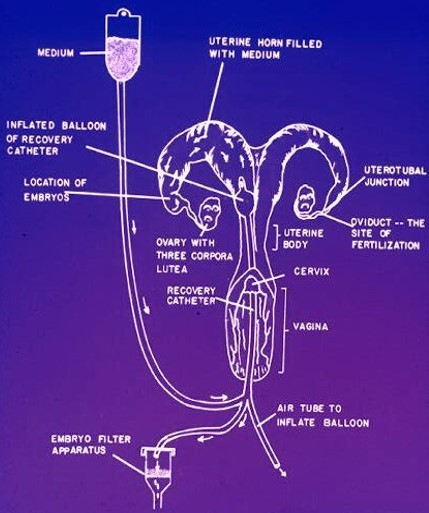
Our Achilles Heel
The Achilles heel of the embryo transfer industry is the unpredictability of the final results even when optimum techniques have been utilized by experienced persons. I have often thought we should regularly obtain at least a 90% pregnancy rate when considering number one quality embryos were correctly transferred, by an experienced technician into a prepared recipient with a recognized corpus luteum (CL) and no detectable infections. I would even say 100% but one has to allow 10% for human error!

A recent publication (Sirard et al) reported the occurrence of transcriptional modifications (changes in the DNA) of eggs leading to lower quality eggs and subsequent lower quality embryos with resulting disappointing pregnancy rates. It is surmised that these modifications occur due to large doses of Follicle Stimulating Hormone (FSH) injected into selected donors the process known as superovulation. The injected FSH is much larger than the surges of FSH released by the animal herself. So use conservative doses of the hormone. Take careful records of FSH doses and record subsequent responses e.g. size of ovaries at flush time, number of eggs, transferable quality and degenerate embryos.
We can improve egg (oocyte) maturation by practicing recommended nutritional requirements so that the donor is not too fat or even too thin. Too fat is often a problem as owners wish to keep their best cows in show condition. There are rare examples of donors repeatedly producing embryos over 40 times and the owners emphasize their animals are kept in working condition i.e. a number 5 or 6 body score. Success can also be improved by testing the donor for anti-mullerian hormone achieved by taking a blood sample. (see previous newsletter for details). After dystocia (difficult calving) or after a retained fetal membrane 50% of these cows will contract endometritis which often remains undetected until flushing time as there is no exudate.
Too few embryos collected in comparison to detected CLs can be a problem when too few flushes are performed or insufficient media are used. Embryos reside in the uterus which has deep folds in the wall making it difficult in some cases for the embryo to be removed into the flushing medium. A recent published study verified the fact that more embryos were recovered when additional flushing was performed and we have experienced similar results. In the early days of embryo transfer we collected embryos (by surgery) by merely flushing the fallopian tubes, a very short distance, compared to the length of the uterus, but we had to repeat the flush at least 3 times to catch all of the embryos. When flushing non-surgically the embryos have to travel from the tip of the uterus all of the way to the cervix so there are many traps on the journey. In addition, uterii vary in size and ability to expand when the media is infused. We fill and empty the uterus at least 5 times in order to achieve maximum chances of recovering most of the embryos.
Unfortunately, there will always be some disappointing results so I often say to my students you must be emotionally strong to accept the inevitable failures especially when preparing one donor at a time-but there will be also be many successful flushes if you persist and learn from failures.
Dr. Peter Elsden
Click to View More Related Articles
Testimonials
"The majority of our insight to embryo transfer is definitely accredited to Dr. Peter Elsden. The pragmatic experiences and personal attention offered through The International Embryo Technology School are highly commendable."… "An example of the benefits to our embryo transfer program, made possible by The International Embryo Technology School, is a cow that produces embryos for only $20 a piece. Each embryo is valued at $1,500 or more! We hold Dr. Peter Elsden and International Embryo Technology School with our highest regard, as they are largely responsible for our accomplishments."
Bob & Robin Stevenson
Stevenson Angus Ranch

|
|
|